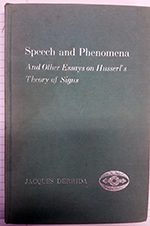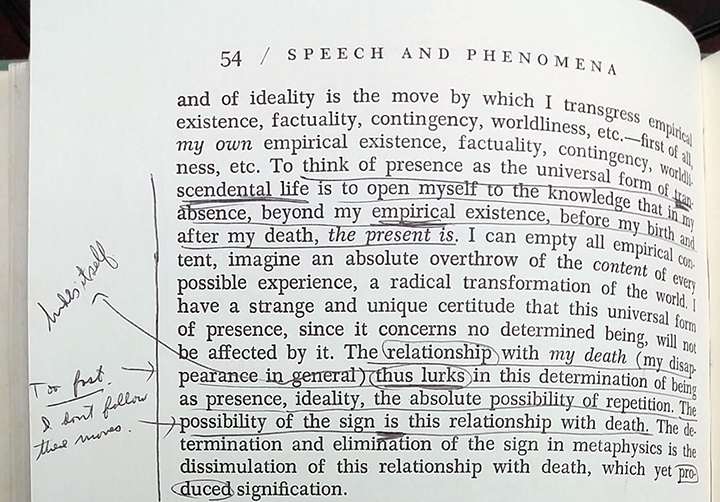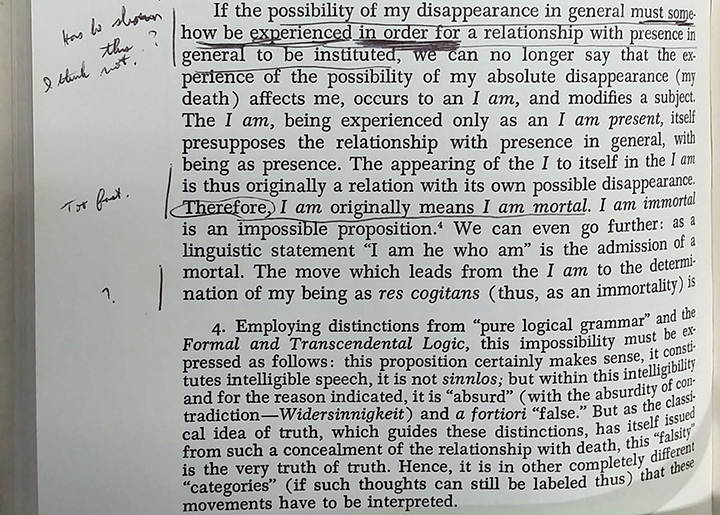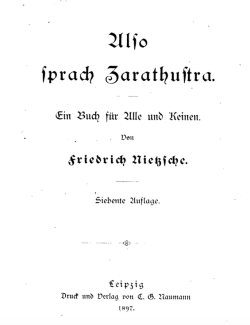
As a way of expressing my gratitude to Justin Weinberg (South Carolina) and Daniel Brunson (Morgan State) for drawing the attention of regular readers of the Daily Nous to this blog, I thought I would dedicate this post to an item in our special collections that bears on a conversation taking place at that website (The “Analytic Co-opting” and Death of the Continental Tradition) and that is itself a response to a set of discussions (part one, part two) on that subject between Babette Babich (Fordham) and game designer Chris Bateman. The book I have in mind is a copy of Jacques Derrida’s Speech and Phenomena (Northwestern UP, 1973) owned and annotated by the philosopher Hubert Dreyfus.
Before turning to Dreyfus’s engagement with Derrida, let me briefly summarize Babich’s complaints concerning the space accorded to continental philosophy within the American academy. On the one hand, Babich describes a situation in which work on continental figures (e.g. Heidegger) has increased among and increasingly belongs to, at least within the American professoriat, philosophers trained in the analytic tradition. In support of this claim, Babich cites Taylor Carman’s presence as one of two invited speakers (Babich was the other) on “Nietzsche and Heidegger” at the Columbia Center for Contemporary Critical Thought’s 2016-2017 seminar series “Nietzsche 13/13.” While Carman regards himself—and is, according to Babich, regarded by his Columbia colleagues—as a continental philosopher, “Taylor is so very analytic that analytic is part of the title of his book.”1 According to Babich, this appropriation of the continental label by philosophers like Carman—who aren’t “at all continental”—”automatically excludes any space for the kind of philosophy I do, which is part of the point.”2 Call this the employability complaint. As Babich puts it, “[While] this does not mean that one will have many positions for Heidegger or Nietzsche experts,…when you do have a position it will be filled by an analyst.”3
If on the one hand Babich sees abundant signs of analytic philosophy’s encroachment on and annexation of the territory held by continental philosophy, she also identifies a threat posed by philosophy’s “increasingly narrower analytic mode.” But, as others have pointed out, this second complaint not only fails as a description of the current state of analytic philosophy it also contradicts the claims of the first complaint. For how can analytic philosophy be at once “increasingly narrow[ ]” and aggressively expansionist? Babich never explains; perhaps such paradoxes can only truly be understood by the inhabitants of the continental tradition.
Career considerations aside, Babich remains committed to the analytic-continental distinction because she sees significant differences between their approaches. For her, continental philosophy “includes a historical sense, a sense of historical context which it does not name ‘the history of philosophy.’” Likewise, it consists in “questioning, elaborating questions, making them more comprehensive, deeper, making them worse, proliferating these same questions and adding more and other associated questions.”4 By contrast, analytic philosophy “privileges argument and persuasion, making a case, making a claim, proving a point, persuading an opponent and so on and it is to this extent fairly legalistic, case-focused.”5
Accepting, for the moment, Babich’s distinction between analytic and continental approaches, I want now to turn to Dreyfus’s annotations to Derrida’s Speech and Phenomena to test the extent to which they conform to her definitions. I think Babich would agree that, along with Nietzsche and Heidegger, Derrida represents the “classical sort[ ] of continental philosophy” with which she identifies and which seeks to defend against encroachment. As a prominent American Heideggerian, Dreyfus would then appear to be, for Babich, the sort of analytic wolf in continental sheep’s clothing she feels endangered by. With that in mind, let us look at a key moment in Dreyfus’s engagement with Derrida.
In chapter four of Speech and Phenomena, Derrida develops a line of thought regarding “the status of representation” in Husserl’s discussion of and contrast between what occurs in effective communication and solitary discourse. For Derrida, “the concept of ideality has to be at the center of such a question.”6 This opens onto a crucial passage, one which Dreyfus marks with double lines in order to indicate its importance for what is to come:

As Dreyfus’s underlinings indicate, Derrida’s crucial moves here are to identify being as “ideality” and “repetition,” indeed as the “possibility of indefinite repetition,” moves which, given the absence of clear marginal objections, Dreyfus appears to accept or, at the very least, to provisionally grant.
It is only on the following pages that Dreyfus registers his resistance. Significantly, this occurs at the point where Derrida’s discussion of being and presence modulates quietly from its previously exclusively Husserlian register into a Heideggerian one.

What is occurring at this point? To what precisely is Dreyfus objecting? As his marginal comments suggest, Dreyfus appears unable to follow Derrida’s line of thinking at this point. While this inability might arguably proceed from an inferiority of intellect, a more charitable reading—and one more consonant with Dreyfus’s own comments—suggests that it stems from a hastiness on Derrida’s part that results in a rather elliptical form of argument: “Too fast. I don’t follow these moves.”
In the paragraph that immediately follows, Dreyfus’s feelings of kinetosis only become more pronounced.

Has he shown this? The question reveals Dreyfus’s understandably analytic assumption that, as a philosopher, Derrida is engaged in the work of argumentation.
But is he right to do so? Babich—at least if we are to take seriously the distinction between the analytic and continental traditions she develops above—would seem to say no—the demand for argument and persuasion belong to an approach to philosophy at odds with the continental tradition’s preference for “elaborating questions” over “making claims.” Nevertheless, in his intuition that Derrida is advancing an argument with an attendant set of claims, Dreyfus seems a far better reader of this representative continental philosopher than does Babich. Significantly, the only question marks that appear on this page belong to Dreyfus. Each of Derrida’s sentences, even those with opening conditionals, is in the declarative mode. Dreyfus thus appears to have good grounds for suspecting the presence of an argument here. Moreover, Derrida signals as much to the reader in his use of argumentative catchwords (“thus”), which are as present in the French (c’est donc) as in the English translation, and, more dramatically, in his repeated use of the copulative “is”: “the sign is this relationship with death”; “the appearing of the I to itself in the I am is thus originally a relation with its own possible disappearance”; “I am immortal is an impossible proposition.” (emphases mine). For a tradition that favors the interrogative mode, this is three claims too many.
It would be a mistake, then, to view Dreyfus’s argumentative expectations as inappropriate, as an unjustifiable demand emanating from a tradition hostile to continental philosophy and ignorant of its own distinctive set of procedures. Far from being extrinsic to Derrida’s project, claim-making is immanent to it. What a reading of Derrida’s text and Dreyfus’s marginalia makes clear is that the issue concerns not (pace Babich) Dreyfus’s failure to respect methodological differences between the two traditions, but something far more banal: Derrida’s failure, at least in Dreyfus’s eyes, to make his case.
- See http://onlyagame.typepad.com/only_a_game/2016/11/babich-and-bateman-1.html. Babich either misses or suppresses the fact that Carman’s title refers not to a recasting of Heidegger in the analytic mode but to Heidegger’s own “existential analytic of Dasein” in Being and Time. ↩
- Ibid. ↩
- Ibid. ↩
- http://onlyagame.typepad.com/only_a_game/2016/12/babich-and-bateman-2.html ↩
- Ibid. ↩
- Jacques Derrida, Speech and Phenomena, trans. David B. Allison (Evanston, IL: Northwestern University Press, 1973), 52. ↩





